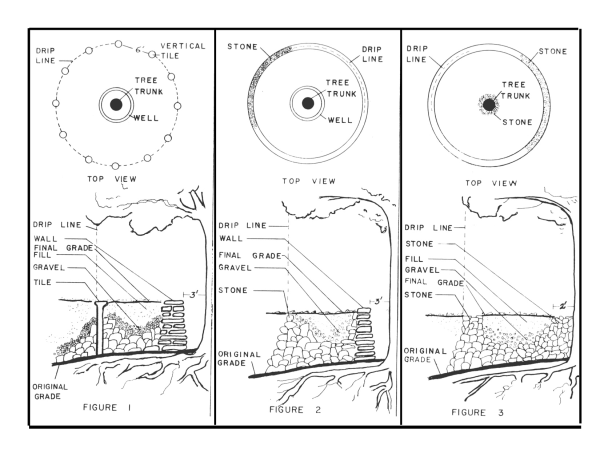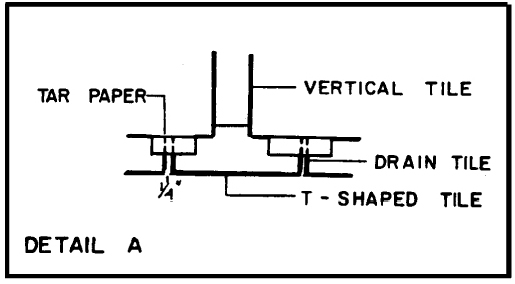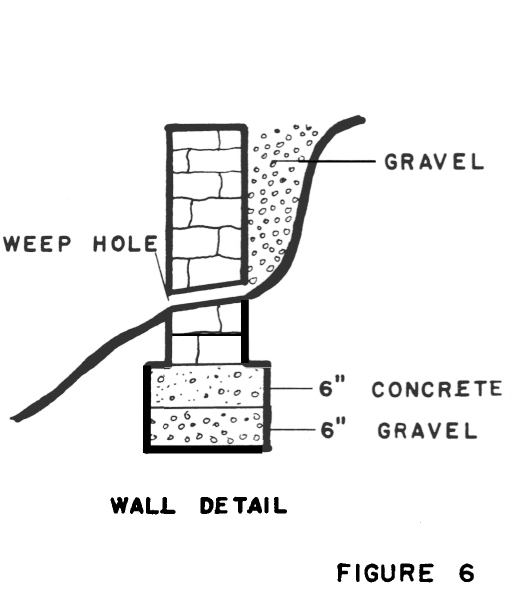Posted by Kristyn Maslog-Levis on Mon, Nov 25, 2013 @ 11:44 PM
How to Create a Tree Well
We came across this interesting paper on raising soil levels around trees. The article “Tree Wells” was written by Clifford W. Collier Jr from West Virginia University in the United States. This was first printed in 1968.
This is an extremely difficult job to do without compromising the tree’s health, but you may find some valid tips in this article. Obviously, every project is different, and the usual recommendations apply regarding consultation with a certified arborist.
Changing the original grade around trees can cause severe injury and in many instances result in the death of trees. Damage to the trees may not show immediately, and several months, a year, or even longer may pass before outward signs of injury are visible. How long before injury begins to show will depend upon the age and species of the tree and the depth of change made in the grade. When signs of injury do appear, the damage is generally too great to save the tree.
Raising the Grade
Raising the soil level around a tree is the most serious grade change. Air circulation is cut off and moisture and nutrients cannot reach the tree roots. In some cases drainage is greatly impaired and the tree drowns.
When the roots are covered too deeply, the first sign of suffocation is generally wilting and defoliation, and the bark begins to decay where soil comes in contact with the tree trunk. The tree may then die slowly or all at once.
Generally, the original grade may be increased 4 to 6 inches a year without damaging the tree.
However, if the grade is to be increased a total of more than 18 inches, a tree well will be needed. A good garden soil, rich in organic matter, should be used for the fill.
Constructing the Tree Well
The prime considerations in constructing tree wells are: (1) air circulation in the root area, (2) water and plant nutrients, (3) proper drainage.

Air Circulation
The best way to insure good air circulation is to pile stone completely over the roots of the tree, as shown in Figures 1, 2, and 3. The stone should extend from the well or tree trunk past the drip line. Figure 1 illustrates the use of vertical drain tile spaced at 6-foot intervals around the drip line of the tree.
Fertilizing and Watering
Supplemental water and plant nutrients can be supplied to the root system through the air vents and drainage system. Supplemental leaf feedings with liquid fertilizers will greatly benefit the tree.


Drainage
Proper drainage is vital to the life of the tree. If the original grade drains properly, an extensive drainage system may not be required. A layer of rock and gravel placed over the entire root system to a depth of 1 to 2 feet should be adequate. If extensive alterations in the grade are made and water does not drain properly, a system of drain tile will be needed, as shown in Figure 4. Make certain that the excess water drains completely from the site, or wet spots may occur in other locations resulting in new problems. Also, make certain that the tile extends through the wall to insure drainage from within the well.
NOTE: Cover all tree wells with a screen or decking to prevent children and small animals from falling into the well and to keep debris from collecting in the well. There are several methods of constructing tree wells, which will provide for air circulation, moisture control, and methods of feeding the tree. There are also many variations of these methods.
The method used will depend upon the value of the tree, the amount of work involved, and the cost.
Tree wells may be constructed of field stone or they maybe permanent, masonry-type walls constructed of brick or other material. In either case, the well should be built before the grade is changed because construction is easier, installation of drain tile simplified, and the well will provide extra protection for the tree against other construction damage.
Size of the Well
A tree well should extend a minimum of 3 feet from the trunk of the tree. The greater the diameter of the well, however, the better the chance of saving the tree. The recommended height for tree wells is 3 feet. Deeper wells have been constructed, however, and have been successful. The additional expense and effort involved is easily justified by the value of the trees and the contribution it makes to the landscape.


Decreasing the Grade
Saving a tree when the grade is to be decreased is not as difficult as when the grade is increased. Move out from the trunk of the tree as far as possible (beyond the drip line is desirable), cut the roots of the trees with a sharp spade or saw, and remove the soil with hand tools to the proper depth. A grader can than remove the rest of the soil without tearing the roots. The crown of the tree should be reduced by 1/3 to compensate for the loss of roots.
A retaining wall should then be built around the tree. Make certain that the wall drains properly. Weep holes every 2 feet are generally sufficient. Gravel placed immediately behind the wall also aids in drainage. The tree should be watered and fertilized the same as if it were growing in the lawn.
Read our case studies here.
Read the original publication here.

